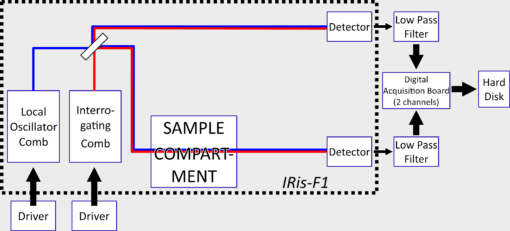IRis-F1 Dual-comb Spectrometer
The IRsweep IRis-F1 spectrometer uses a dual frequency comb laser source to provide high signal-to-noise measurements with microsecond time resolution.
This spectrometer is an excellent complement to broadband FT-IR measurements where information about the dynamics of the system of interest is limited by the useful time resolution of rapid-scan measurements or by the reproducibility requirements of step-scan measurements.
Time-Resolved Measurement Modes
There are a number of different measurement modes with implications for time resolution.
Static Measurement
Closest to a traditional FT-IR rapid-scan measurement, but with faster measurement rates and times.
- Traditional background measurement
- Sample measurements can be repeated as needed
- Rapid multiple static acquisition limited by repetition rate / signal-to-noise requirements
- Example: 1 ms acquisition has minimum 7 ms duty cycle for up to 3.4 s with good noise floor
- Duty cycle can be specified
- Measurement can continue indefinitely at reduced duty cycle (256 ms for above 1 ms example)
- Start of measurement can be triggered
Triggered Static
Same as Static Measurement, except each measurement is controlled externally.
- Single trigger to collect single measurement
- Duty cycle and repetition rate are determined by external trigger
Triggered Time-Resolved
Best time resolution, similar to FT-IR step-scan measurement.
- Background is collected as pre-trigger samples for each repetition
- Requires a sample system with a reproducible trigger (like step-scan)
- Finite time window
- Sample measurement repeated to build S/N (co-addition)
- Default time resolution is 4 µs, minimum is 1 µs
More Information
The IRsweep website has an introduction to the dual-comb laser technique and advantages:
Schematic

| Center Wavenumber | 1650 cm⁻¹ |
|---|---|
| Bandwidth | 50 cm⁻¹ |
| Spectral Sampling | 0.3 cm⁻¹ |
| Linewidth | <10 MHz (0.0003 cm⁻¹) |
| Time Resolution | <1 μs |